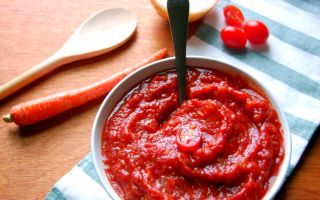Content
- 1 What is this product
- 2 The chemical composition and calorie content of tomato paste
- 3 Useful properties of tomato paste
- 4 Is tomato paste good for pregnancy
- 5 At what age can you give tomato paste to children
- 6 Tomato paste for diabetes and pancreatitis
- 7 Is there any benefit from tomato paste for weight loss and diet
- 8 The use of tomato paste in cooking
- 9 How to make tomato paste at home
- 10 Harm of tomato paste and contraindications
- 11 How to choose and store tomato paste
- 12 Conclusion
The benefits and harms of tomato paste for the human body are determined by the presence of important biologically active substances in its composition. It is in demand in cooking, it is used as one of the additional ingredients in the preparation of various dishes, due to which the latter acquire a characteristic rich taste.
What is this product
Tomato paste is a product obtained by processing tomatoes, followed by heat treatment of the resulting mass. Only ripe and juicy tomatoes are used, mainly red in color, because lycopene is an antioxidant and, at the same time, a coloring pigment, determines the intensity of the red color of the original vegetables. The fruits are pre-peeled and the seeds are removed, and the remaining pulp is crushed and boiled to a thick consistency.
After heat treatment, the water content in the tomato paste is significantly reduced, but, naturally, the amount of dry matter increases. The result is a finished semi-finished product: the thicker it is, the higher its quality.
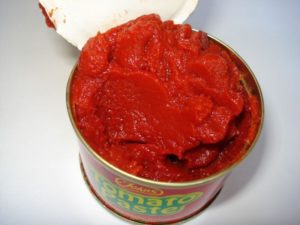
The history of the origin of tomato paste is rooted in the history of Italian cuisine. In the land of the sea and the sun, chefs used it to cook various sauces, soups, and add them to baked goods. It was possible to vary the taste characteristics due to the additional inclusion of various spices and oils.
The chemical composition and calorie content of tomato paste
Natural tomato paste contains only fresh vegetables and salt. The presence of flavor enhancers and preservatives is unacceptable. The presence of spices translates the product into the category of ketchup.
The dry matter content per 100 g of the product varies from 20 to 45%, the rest is water. The average caloric value of tomato paste ranges from 80-130 kcal per 100 g, the energy value is: fats - 0.4 g, proteins - 4.5 g, carbohydrates - up to 20 g.
The biochemical composition of tomato paste is almost the same as that of fresh fruits:
- vitamins: groups B, PP, A, E;
- iron, potassium, phosphorus, magnesium;
- carotene;
- lycopene;
- thiamine and serotonin.
The health benefits of tomato paste due to the increased concentration of nutrients are high.
Useful properties of tomato paste
First of all, tomato paste gives dishes a specific pleasant taste and color, which has a positive effect on appetite and digestion.
Tomato product properties:
- stimulates the production of gastric juice and promotes better absorption of food;
- increases immunity and protective functions of the body, serves as a barrier against viruses and bacteria;
- normalizes brain activity and the nervous system as a whole;
- prevents early aging of the body, which is directly related to the presence of vitamins: A, E and C;
- soothes, relieves nervous tension and relieves stress;
- neutralizes the consequences of radioactive and chemical damage;
- stabilizes carbohydrate balance, normalizes metabolism;
- has a beneficial effect on the cardiovascular system: prevents the development of heart attacks and strokes;
- lowers the level of "bad" cholesterol in the blood and blood pressure;
- normalizes hormonal levels.
Of particular value in tomato paste is lycopene - a pigment of natural origin with powerful antioxidant properties, which gives a rich red color to vegetables. The substance destroys cancer cells and helps in the fight against cancer. Thanks to him, the use of tomato paste for men and women increases many times over, in the prevention of cervical and prostate cancer.
Is tomato paste good for pregnancy
For pregnant women, the benefits of tomato paste lie in its rich vitamin and mineral composition, which contributes to the full development of the fetus and prevents vitamin deficiency in the mother's body. Tomato paste is indicated for better digestive system function and prevention of constipation.
Allowed the use of the product of a young mother in moderation 3-4 months after childbirth. It is advisable to cook it yourself, from environmentally friendly products.
At what age can you give tomato paste to children
Tomato paste is considered an allergenic product, and it is contraindicated for children under the age of three. In the future, it is permissible to include it in moderation in different dishes: soups, meat, fish, stewed cabbage, etc., gradually accustoming the child to new food and taste sensations.
It is not recommended to use factory-made tomato paste in the child's diet, due to the presence of some undesirable ingredients in the composition. The best option is homemade pasta.
Tomato paste for diabetes and pancreatitis
You can not use tomato paste in the acute form of pancreatitis. This is especially true for a product with added preservatives. If you cannot give up tomato concentrate, consume it in small quantities.
Diabetes mellitus is not a contraindication to eating both fresh tomatoes and processed into a paste. The concentrate is nutritious, low in calories and does not contribute to the accumulation of fatty deposits in the body. Due to its slow absorption, it does not cause sharp surges in blood glucose, provided that it is consumed in moderation.
Is there any benefit from tomato paste for weight loss and diet
Despite the fact that tomatoes by themselves do not affect the process of burning fat, they contain many valuable substances, including ascorbic acid, which speeds up metabolism and maintains normal immunity.
Tomato paste has certain benefits for the liver, cleansing it of toxins and toxins. Thus, the load on the organ decreases, and metabolic processes are normalized, which serves as the prevention of obesity.
Canned tomato paste is often used in a variety of diets. This is due to the presence of fiber in it, thanks to which the dishes become more satisfying and tasty.
The use of tomato paste in cooking
Tomato concentrate is in demand in cooking, as an auxiliary component to the first and second courses, sauces, baked goods. It is added to the main course during the cooking process. And also tomato juice is restored from the concentrate.
It goes well with fish, meat, all kinds of side dishes, vegetables, and serves as a dressing for soups. It is convenient to use the pasta in winter, as it is a full-fledged alternative to fresh tomatoes and does not differ from them in taste.
How to make tomato paste at home
Tomato paste is easy to make at home.For this, juicy and fleshy fruits, dark red or brown in color, are selected. The cooking process includes:
- sorting vegetables, with rejection of damaged and spoiled;
- thorough rinsing under running water;
- slicing and grinding;
- cooking, about 15-20 minutes;
- adding spices to the resulting mass.
Further, the resulting mass is poured into prepared glass jars and hermetically closed.
Classic Tomato Paste Recipe
Initial product: tomatoes ("cream" variety) - 4.5-5 kg.
Cooking process:
- The fruits are thoroughly washed and finely chopped.
- Place in a container with a non-stick coating, put on fire and bring to a boil. Maintain with constant stirring over low heat for 25-30 minutes, until the vegetables become soft.
- Remove from heat, remove the skin and grind the remaining mass through a sieve. This removes seeds and other solids.
- Then, boil again, with occasional stirring, until a pasty consistency is obtained and over low heat for 3-3.5 hours.
- The resulting hot mass is laid out in a pre-sterilized glass container, the jars are twisted, turned upside down, covered with a blanket, and left for a day.
This is a universal recipe, but if desired, you can change it by adding: edible salt (35 g), red pepper (3-4 g), chopped garlic (1 pc.).
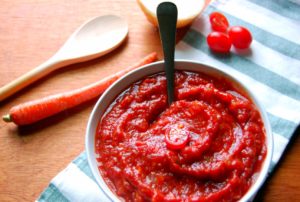
Delicious tomato paste for the winter
Initial products:
- 2.5 kg of tomatoes;
- 3 heads of onions;
- one head of garlic;
- 25-30 g fine salt;
- ground red pepper - 2 g;
- 110 ml of unrefined vegetable oil.
Preparation:
- The tomatoes are poured over with boiling water and the peel is removed.
- Peel and chop onion and garlic.
- Stir and simultaneously grind the tomatoes with a blender to a homogeneous consistency.
- Transfer to an enamel container, add onions and put on low heat for 20-25 minutes.
- Then, the resulting mass is rubbed through a sieve.
- Contribute: garlic, oil and spices. Reheat and continue to boil for another quarter of an hour, with constant stirring.
- Distribute the still hot mass into pre-prepared jars and roll up.
- Turn the cans upside down and cover with a blanket for a day, until they cool completely.
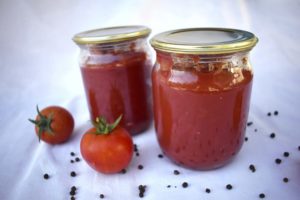
Harm of tomato paste and contraindications
Along with the benefits, there is also some harm of tomato paste for the human body. The presence of organic acids in it irritates the intestinal and gastric mucosa. This increases acidity and can cause heartburn.
In moderate quantities, a natural product is harmless to a healthy person. Unscrupulous manufacturers are trying to reduce the price of their goods by introducing stabilizers, flavorings, starch, dyes, emulsifiers into the composition. Be careful when buying tomato concentrate, read the ingredients.
Tomato paste is contraindicated for people with pathologies:
- duodenal ulcer and stomach;
- gastritis, with high acidity;
- individual intolerance to individual components;
- gout;
- arthritis;
- stones in the kidneys and gallbladder.
Eliminate the product from the diet for allergies to red vegetables and fruits.
How to choose and store tomato paste
When buying tomato paste, preference is given to glass containers, which facilitates visual diagnostics of the goods. The quality of products is evidenced by the following indicators:
- homogeneous thick consistency;
- reddish reddish tint;
- lack of lumps and air bubbles.
When closed, the shelf life of the product, from the moment of production, depending on the packaging, is: in glass containers - 2 years, metal containers - 1 year, including aluminum containers - 6 months.
After opening, the tomato product is stored in the refrigerator for no more than two weeks. To extend the shelf life, it is recommended to pour a small layer of olive or sunflower oil on top.
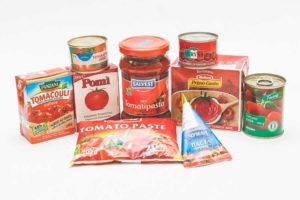
How to choose the right tomato paste, - the video will tell you:
Conclusion
The benefits and harms of tomato paste depend solely on the quality of the basic ingredients that make up the composition and the production technology. The correct dosage plays an important role. Even the most useful product, consumed in large quantities, can harm health. It is best to prepare the product yourself - from vegetables grown on your own backyard.

